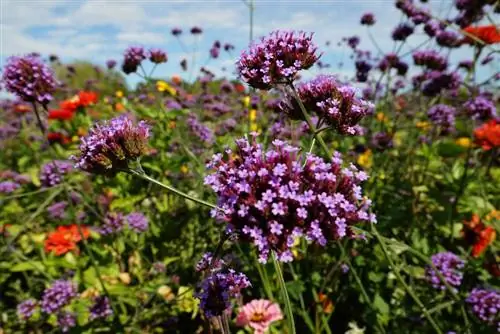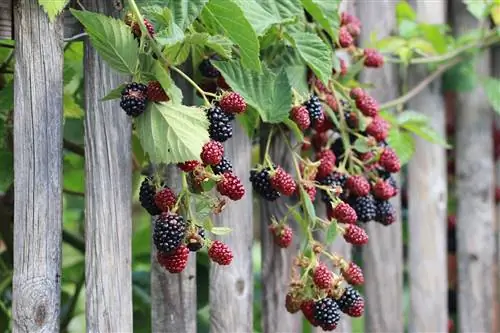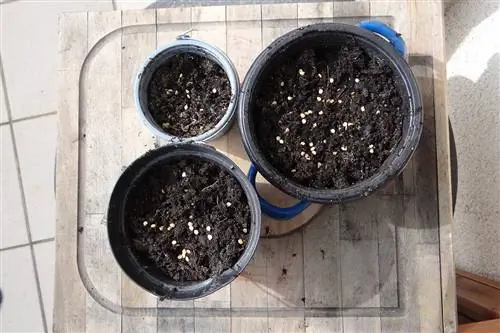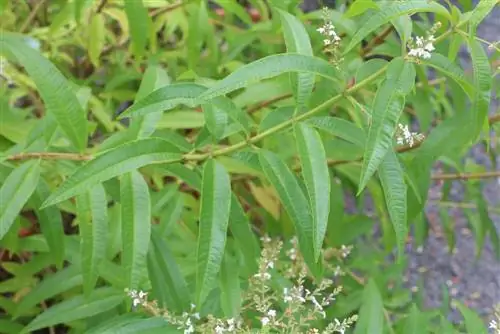- Author admin [email protected].
- Public 2023-12-17 03:39.
- Last modified 2025-01-24 12:45.
Patagonian verbena can inspire, as it proved as a crowd favorite at state garden shows in the 1980s. It is difficult to understand why Verbena bonariensis has been so forgotten since then - if it is due to the frequently invoked "one-year-old nature", this is exposed as a "fake" in the article. If you love your garden to be bursting with flowers without much effort, Patagonian Verbena is the plant for you - its modest demands in any reasonably suitable location will surprise you:
Patagonian Verbena
- Verbena bonariensis belongs to the verbena family
- The tall plant develops a sea of purple flowers that appear to float on the stems
- Planted in groups of several in an area creates a spectacular impression
- Which you can enjoy from June to October, an “endless” flowering period
- Also very persistent in the vase and as a dried flower
- The South American perennial is a perennial and can survive German winters in many regions with a little protection
- In cold areas, wintering could be difficult
- But you only need to let a few seeds ripen and the verbena will appear reliably next season
- The care is hardly worth mentioning: in the right location you only have to remove the old stems in spring
- In addition to the natural variety, the varieties 'Cloud' (larger flowers) and 'Lollipop' (compact dwarfism) are available
Location and soil requirements
The Patagonian or Argentine vervain has its origin in its name, so the natural location is under the South American sun. Verbena bonariensis grows as a tall, slender perennial that forms clumps and stretches upright towards the sun. A striking and special summer flower that really looks great in the garden, especially if you plant larger areas with the verbena plant: The perennial bloomer develops tall shoots, but very fine ones with little foliage, which of course become even finer and thinner towards the top. On the other hand, the flowers, which appear repeatedly throughout the season and only at the ends of the shoots, have a stronger structure, intense color and an unmissable circumference of between 5 and 10 cm.
A contrast that deserves to be highlighted because it creates a quite spectacular effect: the flowers of Patagonian verbena look like a horde of flowering balls that seem to float above delicate, isolated greenery. These flowers “float” without the need for support from the stems, and they float for an unusually long time, from May/June until late fall; i.e. the entire time in which the garden is used to rest, relax and admire the flowers.
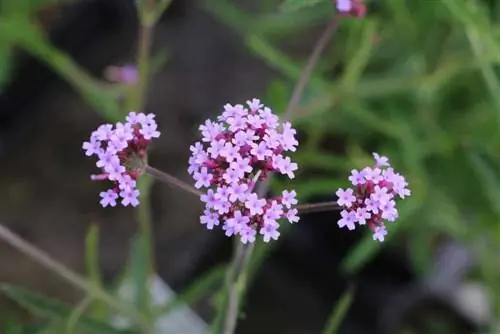
The British Royal Horticultural Society (RHS) also finds Patagonian verbena interesting and closely examined the talents of Verbena bonariensis as a garden plant in 2002. This also includes a precise description of the properties and requirements of the species:
- Names: Botanically Verbena bonariensis, locally Patagonian or Argentine Verbena
- Synonyms of the botanical name: Verbena bonariensis 'Buenos Aires' (double doubled, bonariensis means Buenos Aires), Verbena brasiliensis (misname)
- Large perennial with erect, branched trunks up to 2 m high
- With sparse, elongated leaves and large branching clusters of small purple flowers from summer to fall
- Distribution: South America
- Foliage: summer green
- Growth: Columnar/Upright
- Scent: flowers
- Color: Green leaves and purple flowers from spring to autumn
- Light, Sun: Full Sun
- Planting direction: south or west side
- Site environment: Patagonian verbena can be planted free-standing or protected (by neighboring plants or house walls)
- Soil: Grows in clayey soil, loamy soil, limestone soil, sandy soil
- Soil moisture: Moist but well drained / well drained
- pH value: acidic, neutral, alkaline
- Adult plant size: Final height 1.5 to 2.5 meters; final width 0.1 to 0.5 meters, time to reach final height: 2 to 5 years
- Pests: Normally no pest infestation
- Illnesses: Normally no illnesses
- Recommendation for use (locations and garden types): flower borders and beds, planting on and around walls, steppe gardens, gravel and rock gardens, city and courtyard gardens
After classification and extensive testing in one of the “royal gardens”, the Patagonian verbena was awarded the “RHS Award of Garden Merit”, which classifies the Patagonian verbena as an excellent garden plant. The RHS sometimes makes very decisive demands, but specifies optimal conditions; if every detail is not correct, the Argentine verbena will certainly still grow.
If the Patagonian verbena is not planted in an open area but in community with other plants, the following planting partners have qualified as good neighboring plants:
- Burning herbs (Phlomis)
- Foxgloves (Digitalis)
- Articular flowers (Physostegia)
- Grasses such as panicle millet (panicum, e.g. switchgrass P. virgatum)
- High girl eyes like Coreopsis tripteris
- Magnificent candles (Gaura)
- Purple Coneflower (Echinacea purpurea)
- Roses (higher shrub or floribunda roses)
Tip:
Patagonian verbena is planted in groups; the larger the group, the better the effect. You can use a special talent of the verbena: In combination plantings, it can be planted on the outside of the edge because it grows semi-transparent and allows plants growing behind it to stand out.
Sowing and Planting
By choosing the right location, you have actually done everything necessary to allow a Verbena bonariensis to thrive. Both sowing and planting young plants is unproblematic, which is why the RHS's “How to grow” is limited to the following sentences: Seeds can be grown in pots from autumn to early spring at temperatures between 18 and 21 °C (or left to self-sow).) become. Plant young plants in moist to dry, well-drained soil in sunny locations and protect them with dry mulch in cold regions in winter.
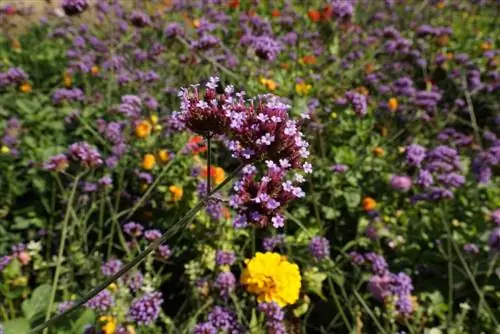
Seeds from stores can be sown without pretreatment, even directly outdoors. Then it's best to do it in the fall, saving stratification (cold treatment to break dormancy) in the refrigerator. Seeds collected from a plant can only be placed in the refrigerator for a few hours or days to stratify before sowing, which otherwise works like this:
- Sowing dates: February-April
- Soak seeds overnight in lukewarm water
- Germination time: At 21-24 °C 5-10 days, longer in colder soil
- Verbenas sown without stratification usually germinate, but possibly only after weeks
- Spread light germinators loosely and dust lightly with substrate
- Occasionally it can be read that V. bonariensis belongs to the dark germs; That's not true, how should such fine seeds fight their way to the surface of the earth?
- Only moisten the potting soil slightly, V. bonariensis germinates best in a medium-humid to dry environment
- The sowing pots can be covered with foil to increase the humidity
- Otherwise, the seeds no longer need to be watered; waterlogging must be avoided at all stages of germination
- When the first true leaves appear after the cotyledons, the small plants are covered
- Then the seedlings can also be pricked out
- You don't have to plant a lot of seedlings individually, you can also simply thin out the existing plants
- When the seedlings are hand-high, they can be trimmed (snip off the shoot tip with your thumb and forefinger) so that they branch better
- When the last night frosts are safely over, the young plants can move into the outdoor bed
Soon flowers will appear in abundance, which are not only a very attractive eye-catcher, but also attract so many bees and butterflies that the Patagonian verbena will also receive a “royal award” as a “Perfect Pollinatinor Plant”. for pollinators).
Tip:
The Patagonian verbena is suitable for planting in containers, but you need a fairly large container for the normal Verbena bonariensis. Alternative: Plant the short-growing Verbena bonariensis variety 'Lollipop', which can even decorate balcony boxes with a height of around 50 cm (Caution: If 'Lollipop' is allowed to spread seeds, they will become tall verbenas again).
Care instructions
The “Award of Garden Merit” certifies to the hobby gardener that the award-winning ornamental plant has the following qualities:
- The species/variety is of outstanding value to gardens when used normally and cultivated under appropriate conditions
- The species/variety is available (for hobby gardeners, in reasonable quantities at reasonable prices and without disproportionate effort)
- The species/variety is of good constitution and generally he althy
- The species/variety is stable in shape and color and the individual plants usually reliably correspond to the sales description
- The species/variety is resistant to diseases and pests, and is not particularly susceptible to a particular disease or parasite.
When it comes to Patagonian verbena, the recipient of this award, the British “How to care” is consequently limited to a single sentence: Pruning: Cut down in spring when the new shoots develop from the base; “head” in the fall if no sowing is desired and the seeds should not be collected.
Since off-island gardeners may not have a few centuries of gardening experience (like most English people), here are a few additional comments:
- Overall, cultivate as dry and airy as possible, this promotes early flower induction
- Usually no additional watering necessary
- In prolonged heat, V. bonariensis also needs additional water
- Verbenas in the pot are watered when the top layer of soil has dried out
- The nutrients in normal soils and also in sandy and stony poor soils are sufficient for the garden verbena
- The bucket needs to be fertilized, about every 2 weeks during the growing season
- Don't let plants grow too close together, if necessary cut out the inside stems, but with a feeling that the shoots support each other
- Outside shoots could be “flattened” by wind and rain if you cut away supporting partners here
- They can also stay because the outside of the plant grows airy enough to make fungal infestation unlikely
- Regularly cutting away spent flowers promotes the creation of new flowers
- Don't forget to let the last flowers ripen on the plant if the plant is to self-seed
Tip:
The long flower stalks of the Patagonian verbena appear delicate, but are strong, square and even woody - otherwise they could neither grow so high without support nor support the large flower umbels. With this stem, V. bonariensis qualifies as an excellent cut flower that should last up to 2 weeks in the vase, and as a long-lasting dried flower. For the vase, cut flowers that are just or not yet fully open. Verbena plants for drying can be harvested at any desired stage of ripeness and hung upside down in a warm and airy place.
Wintering
In the Award of Garden Merit, the characteristic “outstanding value under normal use and proper treatment” includes the “RHS hardiness rating”, in which the Patagonian verbena is classified in hardness class H4: Most of the UK has average temperatures below zero Frost hardy between -5 and -10 °C. In the “rest of the world,” Verbena bonariensis is classified in USDA international hardiness zones 7 to 11, meaning it is expected to survive at average winter minimum temperatures of +10°C to -17.8°C.
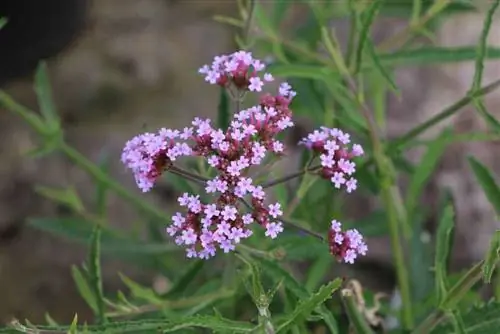
In parts of Germany it will be colder than in England, our country covers USDA hardiness zones 8 to 6. If you believe the international classification, it will be colder in residential areas with USDA hardiness zone 6 (−17.8 °C to − 23.3 °C) closely related to the overwintering of Patagonian verbena; If you believe the British, wintering is a problem everywhere in Germany. This fact explains why Patagonian verbena is alternately described as a perennial and an annual, when in fact it is a perennial. But it is also certain that winter hardiness and German winter wetness are not the strengths of the Patagonian verbena.
Since all of the winter hardiness zone information just mentioned only refers to average temperatures, there can be difficulties with wintering even in mild German areas if the winter develops a few additional temperatures below zero. If you want to safely overwinter a particular, rare-colored Argentine verbena, you should dig it up before the permanent frost and either overwinter it in a pot or, like dahlias, with bare roots.
Otherwise, in mild locations you can take it easy - if the verbena does not manage to overwinter, it usually ensures its survival in the next season by self-sowing in the given location. The following preparations increase the chances of the old plants overwintering:
- Let the plant go into the winter with full foliage and whole stems
- Apply dry mulch of leaves, brushwood, straw around the roots
- Which stays until after the last late frosts
- Shortly before budding in spring, cut back last year's leaves completely
- Patagonian verbena in the pot overwinters in a cool, but frost-free and bright room and occasionally receives little water in the winter
- Bunts are only allowed outside again when there is no longer any risk of late frost (after the Ice Saints in mid-May)

